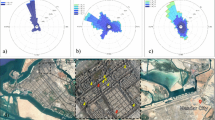Abstract
Urban canopy parameterizations (UCPs) are necessary in mesoscale modelling to take into account the effects of buildings on wind and turbulent structures. This study is focused on the dynamical part of UCPs. The main objective is twofold: first, computing important UCP input parameters (turbulent length scales and the sectional drag coefficient) by means of Reynolds-averaged Navier–Stokes (RANS) simulations of turbulent flow; and second, comparing UCP variables with spatially-averaged properties obtained from RANS simulations for the same configurations. The results show the importance of using a suitable parameterization of the drag force for different packing densities. An urban canopy parameterization that is a compromise between simplicity and accuracy is proposed. This scheme accounts for the variation of drag coefficients with packing densities, and has a parameterization of turbulent length scales. The technique adopted ensures that, at least for the simple configurations studied, the urban canopy parameterization gives values of spatially-averaged variables similar to those computed from a more complex simulation, such as RANS that resolves explicitly the flow around buildings.
Similar content being viewed by others
References
Bougeault P, Lacarrere P (1989) Parameterization of orography-Induced turbulence in a mesobeta-scale model. Mon Weather Rev 117: 1872–1890
Britter RE, Hanna SR (2003) Flow and dispersion in urban areas. Annu Rev Fluid Mech 35: 469–496
Brown M, Williams M (1998) An urban canopy parameterization for mesoscale meteorological models. In: AMS 2nd urban environment symposium, Albuquerque, NM, pp 144–147
Cheng H, Castro IP (2002) Near wall flow over urban-like roughness. Boundary-Layer Meteorol 104: 229–259
Cheng H, Hayden P, Robins AG, Castro IP (2007) Flow over cube array of different packing densities. J Wind Eng Ind Aerodyn 95: 715–740
Coceal O, Belcher SE (2004) A canopy model of mean winds through urban areas. Q J Roy Meteorol Soc 130: 1349–1372
Coceal O, Thomas TG, Castro IP, Belcher SE (2006) Mean flow and turbulence statistics over groups of urban-like cubical obstacles. Boundary-Layer Meteorol 121: 491–519
Di Sabatino S, Solazzo E, Paradisi P, Britter R (2008) A simple model for spatially-averaged wind profiles within and above an urban canopy. Boundary-Layer Meteorol 127: 131–151
Grimmond CSB, Oke TR (1999) Aerodynamic properties of urban areas derived from analysis of surface form. J Appl Meteorol 38: 1262–1292
Hagishima A, Tanimoto J, Nagayama K, Meno S (2009) Aerodynamic parameters of regular array of rectangular blocks with various geometries. Boundary-Layer Meteorol 132: 315–337
Hamdi R, Masson V (2008) Inclusion of a drag approach in the Town Energy Balance (TEB) scheme: offline 1D evaluation in a street canyon. J Appl Meteorol Clim 47: 2627–2644
Kanda M, Kawai T, Kanega M, Moriwaki R, Narita K, Hagishima A (2005) A simple energy balance model for regular building arrays. Boundary-Layer Meteorol 116: 423–443
Kondo H, Genchi Y, Kikegawa Y, Ohashi Y, Yoshikado H, Komiyama H (2005) Development of a multi-layer urban canopy model for the analysis of energy consumption in a Big City: structure of the urban canopy model and its basic performance. Boundary-Layer Meteorol 116: 395–421
Kusaka H, Kondo H, Kikegawa Y, Kimura F (2001) A simple single-layer urban canopy model for atmospheric models: comparison with multi-layer and slab models. Boundary-Layer Meteorol 101: 329–358
Macdonald RW (2000) Modelling the mean velocity profile in the urban canopy layer. Boundary-Layer Meteorol 97: 25–45
Martilli A (2007) Current research and future challenges in urban mesoscale modelling. Int J Climatol 27: 1909–1918
Martilli A, Santiago JL (2007) CFD simulation of airflow over a regular array of cubes. Part II: analysis of spatial average properties. Boundary-Layer Meteorol 122: 635–654
Martilli A, Clappier A, Rotach MW (2002) An urban surface exchange parameterization for mesoscale models. Boundary-Layer Meteorol 104: 261–304
Masson V (2000) A physically based scheme for the urban energy budget in atmospheric models. Boundary-Layer Meteorol 94: 357–397
Masson V, Seity Y (2009) Including atmospheric layers in vegetation and urban offline surface schemes. J Appl Meteorol Clim 48: 1377–1397
Pope SB (2000) Turbulent flows. Cambridge University Press, New York, p 771
Raupach MR, Shaw RH (1982) Averaging procedure for flow within vegetation canopies. Boundary-Layer Meteorol 22: 79–90
Santiago JL, Martilli A, Martín F (2007) CFD simulation of airflow over a regular array of cubes. Part I: three-dimensional simulation of the flow and validation with wind-tunnel measurements. Boundary-Layer Meteorol 122: 609–634
Santiago JL, Coceal O, Martilli A, Belcher SE (2008) Variation of the sectional drag coefficient of a group of buildings with packing density. Boundary-Layer Meteorol 128: 445–457
Uno I, Ueda H, Wakamatsu S (1989) Numerical modelling of the nocturnal urban boundary layer. Boundary-Layer Meteorol 49: 77–98
Xie Z-T, Coceal O, Castro IP (2008) Large-eddy simulation of flows over random urban-like obstacles. Boundary-Layer Meteorol 129: 1–23
Author information
Authors and Affiliations
Corresponding author
Rights and permissions
About this article
Cite this article
Santiago, J.L., Martilli, A. A Dynamic Urban Canopy Parameterization for Mesoscale Models Based on Computational Fluid Dynamics Reynolds-Averaged Navier–Stokes Microscale Simulations. Boundary-Layer Meteorol 137, 417–439 (2010). https://doi.org/10.1007/s10546-010-9538-4
Received:
Accepted:
Published:
Issue Date:
DOI: https://doi.org/10.1007/s10546-010-9538-4




